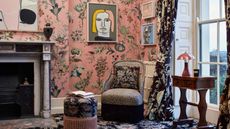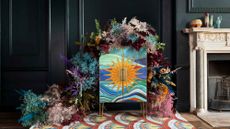The Loewe Foundation Craft Prize 2020 finalists put everyday materials in a new light
An expert panel has whittled down 2,920 global submissions to just 30 stand-out pieces, each one demonstrating an exceptional ability of material experimentation and innovation. Here are some of our favourites...

The finalists have been announced of the Loewe Foundation Craft Prize 2020, the annual award that celebrates contemporary makers.
Thirty global finalists have been shortlisted for the prestigious award from 2,920 total submissions. Each shortlisted work demonstrates genius material experimentation and innovation.
The finalists range from newly emerging artists to esteemed leaders in their fields, and hail from six continents and 18 different countries.

All of the entries are original, one-of-a-kind handmade works, featuring interesting fusing of materials using ceramics, lacquer and enamelwork, to glass, paper, and wood.
the finalists have looked to up-cycled materials and how these can be turned skilfully into objects of beauty and resonance.

It took the experts panel two days to whittle down the shortlist to just 30 one-off works which they consider most outstanding, representing excellence, newness, innovation and artistic vision in modern craftsmanship.
Comprising 12 leading figures from the world of design, architecture, journalism, criticism and museum curatorship, the experts panel includes last year’s winner Genta Ishizuka, former director of Design Museum Deyan Sudjic, and architect and designer Patricia Urquiola among others.

The overall winner will be announced in Paris on 19th May, with a cash prize of 50,000 euros and with global recognition for contribution to craft.
Each of the 30 finalist’s works will be exhibited at the Musée des Arts Décoratifs in Paris from 21 May to 12 July 2020. Here are a few of the selected submissions that are shortlisted for the award...
1. METAL
A statement against the abuses of industrial copper mining in the Atacama Desert in Chile, this geomorphic sculpture by David Corvalán ismade from copper wire and resin and captures the brightness, colour and fragility of this ancestral environment.

Meanwhile a brooch made from upcycled staples is a reflection on mass production. Through repetitive actions of layering, patterning and systemically constructing, Jess Tolbert replicates the processes of mass production and reflects on its unknown makers. The resulting piece of jewellery renders unrecognisable a common, utilitarian material.

Fascinated with the possibilities of combining and casting different metals, Peter Bauhuis has created a series of vessels with an almost painterly quality.

In Naama Haneman's 'Movement', brass and sterling silver are soldered together and the resulting thin sheet is hammered into a contradictory form, which delivers a dialogue between the seen brass of the exterior and unseen silver beneath it.

While in this series of exquisite, airy vessels by Sungho Cho, new possibilities in casting metal are demonstrated.

Thin sheets of silver are cast in a beeswax-lined mold and soldered together. Intricate patterns, stamped into the beeswax, appear etched onto the surface.

2. WOOD
This bold and dynamic sculpture by Darshana Raja is made from mvuli wood offcuts, and assembled in a precise and controlled mathematical configuration.

Straight, wooden sticks are transformed into beautiful curves, creating a sunlike and transient presence that is a result of Raja’s rhythmic and elegant arrangement.

Raja incorporates the Japanese method of shou sugi ban to treat the wood’s surface, adding depth to the material.
Meanwhile, Kohei Ukai's remarkable example of Japanese lacquer work, measuring 2m in length, is made by pouring layer upon layer of urushi lacquer onto a piece of carved Japanese linden wood.

This creates a rich and reflective surface coating that appears to melt off the edges, its brilliance a contrast to the dry and textured nature of the wood.
Creating a different effect altogether, this extraordinary piece of furniture by Yang Gao is made entirely of bamboo.

Gao hammers and splits the ends of bamboo sticks to create forms resembling dandelions, meticulously layering each one to create a voluminous ottoman-style structure.

Creating a rigid framework of support, Gao miraculously produces a soft appearance out of a fundamentally hard material.
Lastly, Despo Sophocleous's necklaces are made from cherry, walnut and ash, and each piece is composed of several interlocking elements which form one movable unit. The hollow, movable spaces create sound when worn on the body.

3. CERAMIC
This distinctive cylindrical vessel by Anthony Marsh embodies the spirit of alchemy and alludes to geographical phenomena. Marsh’s highly experimental process favours unpredictable results, exposing the topographical surface possibilities of the ceramic material and creating sublime shades of blue.

In contrast, so paper-thin they are nearly transparent, this group of porcelain vessels by Bodil Manz appears at once delicate and strong.

While this ethereal and potent workby Jack Doherty is inspired by the archetypal ritualistic vessel. Soda administered to the porcelain during the firing process produces an electric, oceanic palette. The scale of the work, combined with its nuanced surface texture, results in an imposing manipulation of light and shadow.

Other impressive submissions are made from glass, stone and even textiles.
Find the full shortlist here.
Be The First To Know
The Livingetc newsletter is your shortcut to the now and the next in home design. Subscribe today to receive a stunning free 200-page book of the best homes from around the world.
Lotte is the Digital Editor for Livingetc, and has been with the website since its launch. She has a background in online journalism and writing for SEO, with previous editor roles at Good Living, Good Housekeeping, Country & Townhouse, and BBC Good Food among others, as well as her own successful interiors blog. When she's not busy writing or tracking analytics, she's doing up houses, two of which have features in interior design magazines. She's just finished doing up her house in Wimbledon, and is eyeing up Bath for her next project.
-
 The Nespresso VertuoPlus is 30% Off for President's Day, and it's Kim Kardashian's Coffee Maker of Choice
The Nespresso VertuoPlus is 30% Off for President's Day, and it's Kim Kardashian's Coffee Maker of ChoiceThis sleek and stylish coffee maker was spotted in Kim's home bar, and you can currently save $60 if you buy yours from Amazon
By Lilith Hudson Published
-
 10 Rules For Decorating Small Spaces - How Designers Create A Cozy Room That Also Boosts The Square Footage
10 Rules For Decorating Small Spaces - How Designers Create A Cozy Room That Also Boosts The Square FootageExperts reveal their tips and tricks on how to combine a welcoming vibe with space-stretching interior design techniques...
By Ruth Doherty Published
-
 The simple way to a more sustainable and stylish life with Fisher & Paykel
The simple way to a more sustainable and stylish life with Fisher & PaykelThis incredible new tech saves time, energy and has become the washing machine you need to know about
By Sponsored Published
-
 Forget Cottagecore - Flora Fantasia by House of Hackney is Cottage hardcore
Forget Cottagecore - Flora Fantasia by House of Hackney is Cottage hardcoreHouse of Hackney's Flora Fantasia collection blends the romanticised rural aesthetic with riotous punk elements
By Jacky Parker Published
-
 Bert & May's new hexagon tiles collection is tapping into one of this year's biggest micro trends
Bert & May's new hexagon tiles collection is tapping into one of this year's biggest micro trendsTap into the microtrend for hexagon tiles and make myriad patterns with this new collection from Bert & May
By Jacky Parker Published
-
 Matthew Williamson’s tip for renovating a house on a budget is so simple, but incredibly effective
Matthew Williamson’s tip for renovating a house on a budget is so simple, but incredibly effectiveRenovating a house on a budget? See the savvy ways to control costs when managing an interior redesign
By Jacky Parker Published
-
 The fabulous new Matthew Williamson furniture collection is a cocktail of color and print
The fabulous new Matthew Williamson furniture collection is a cocktail of color and printThis decorative Matthew Williamson furniture is the beautiful result of collaboration with Roome London
By Jacky Parker Published
-
 Out & Out's new furniture collection is full of stylish storage solutions
Out & Out's new furniture collection is full of stylish storage solutionsThis stylish storage will have your home organised in a jiffy - whatever its size
By Jacky Parker Published
-
 Explore Sandra Bullock’s former coastal chic home in Georgia
Explore Sandra Bullock’s former coastal chic home in GeorgiaSandra Bullock has just sold her beautiful island beach house, giving us a glimpse at her coastal-inspired interior style.
By Lotte Brouwer Published
-
 On your marks: new H&M furniture, lighting and homeware for SS21 about to drop
On your marks: new H&M furniture, lighting and homeware for SS21 about to dropThe new H&M furniture, lighting and homeware collections drop on 4 Feb, so earmark your favourite pieces now
By Jacky Parker Published









